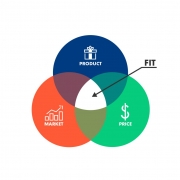Mindfulness for leadership, focus and creativity

According to Wikipedia, mindfulness, translates as full attention, alert mind or full awareness. If we are strict about the origin of the word, mindfulness means the essence of the Vipassana measurement stream. Whereas other types of Buddhist measurement aim to empty the mind of any conscious reasoning or direct attention to a single image or idea, Vipassana practitioners seek to uncritically gain awareness of all thoughts and emotions experienced in the moment.
Attention: this rich and delicate philosophy cannot be explained in detail in just a few lines. The objective here is just to expose the concept to those who are interested in the subject or have heard about it but do not know what mindfulness means in practice. Personally, I believe that the frequent practice of Vipassana meditation can bring more focus, calm and energy to the mind and body. Specifically, Vipassana followers believe that our minds are constantly busy re-processing the past or anticipating the future, allowing little time and energy to truly live in the present. Theory comes to practice through simple exercises that can be practiced by anyone, anywhere. The principle is to focus on the breath, for example, and indirectly increase awareness of what goes through the mind, always in a non-critical and detached way.
Although a monastic life dedicated exclusively to the contemplation of the moment is light years away from the world most of us live in – that is to say the rush, the hustle, the emails, the pressure (external and internal) – there is a growing interest in how the principles of this practice can be applied to our lives in a pragmatic and realistic way. American psychologist and professor Ellen Langer has been studying mindfulness for a number of years, and her main theory is that practice plays an important role in the learning process. For her, meditating often increases her ability to see the world through constantly new angles. New angles, of course, require curiosity and commitment, as well as letting go of past concepts.
Letting go of old ideas, she warns, is especially difficult because possibly these “ideas” are already part of our DNA and we are not aware of them. With greater awareness of what we know and what we don’t know, we become more open and creative to new solutions.
Meditation & Leadership
In March of 2013, an important American newspaper dedicated a page to this topic: what is the interface between mindfulness and leadership? Who responded was Bill George, professor at Harvard Business School, former CEO of a billion-dollar company, and strong advocate of a productive, creative and authentic lifestyle. Bill argues that the subject is so much in evidence that at the last World Economic Forum in Davos the most attended lecture was given by the Buddhist monk Matthieu Ricard. The latter, French and scientist with a doctorate in the West, is a scientific adviser to the Dalai Lama and author of the book Art of Meditating.
What is causing this dramatic shift in the way we think about what it takes to be an effective leader today? Well, it starts with the changes taking place in the world. We live in an era where globalization and advancing technological change create volatility, uncertainty, chaos and ambiguity. This impact grows exponentially through a job market in constant transformation and the new world where communication is present 24 hours a day. Seven days a week.
See how interesting: companies like Google, General Mills, Genentech, Target and Cargill, for example, have developed training programs for their employees focusing on mindfulness and leadership. The expected (and achieved) benefits are summarized in more creative, focused and determined managers. The correct word is resilience, but other adjectives help color the impact of meditation practice.
Following Professor George, practicing meditation for 20 minutes a day (I practice 10 and I believe it already has an effect) is essential to increase your effectiveness and sense of well-being. He has been doing it since 1975, and the result can be measured through his resume.
“Meditation allows me to forget about unimportant things and focus clearly on the important matters. My most creative ideas come from meditation. Also, meditation improves my energy level and allows me to have more compassion for others”, says Bill.
You see, it’s not just sitting down for 10-20 minutes a day, every day, that brings you the benefit of mindfulness. Praying regularly, keeping a journal, interesting and intimate discussions with people close to you, and solitary exercises such as running, walking, or swimming make us live in the present. The most important thing is to have a form of introspective practice that allows you to calm your mind and focus on what really matters.
Advancing towards the “what can I do?”, is the suggestion, scientifically proven, to practice meditation for 10 minutes daily. The important thing is to have discipline and follow the plan regardless of the context. Establish your routine as you see fit. Personally, it works well in the morning, after showering and before breakfast. Having a dedicated chair or cushion for practice also helps. And for beginners, guided meditation is an excellent tool to help “tame” the mind.
Article originally written in December 2013









